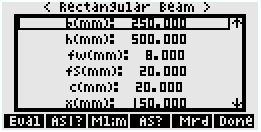Civil is a C language add-in written in Casio 9860 SDK that can analyze concrete sections according to Eurocode. It can calculate and design beam and column sections, find geometric properties of sections, and calculate yield and ultimate rotations for concrete columns.
All the calculations of the software are exact and based on forces equilibrium, so it is possible to see some differences in the results from references and pre-calculated concrete tables. On beam design the neutral axis x is searched with a simple iteration, and on column design a more robust newton method is used.
- Beam design (Beam – F1)
Selecting from the main menu, Beam (F1) we can select from a popup menu, between rectangular and tau-shape section for the beam.
Now a list will show up with all the parameters of the section: b(mm) the width of rectangular beam, h(mm) the height of rectangular beam, fw(mm) the diameter of shear steel, fs(mm) the diameter of bending steel, c(mm) the cover of steel, x(mm) the distance of neutral axis, Nd(kN) the axial force (compression is negative), Md(kNm) the moment, As1(cm^2) the steel of the tensed edge, As2(cm^2) the steel on the compressed edge, fc(MPa) the compression resistance of concrete, gc the compression resistance factor of concrete (usually 1.5), the acc factor of concrete (usually 1.0 or 0.85), fy(MPa) the tension resistance of steel, the ft/fy factor (usually 1.00 to 1.15), gs the tension resistance factor of steel (usually 1.15), eco the tension limit of concrete usually (2.0/1000), ecu the ultimate compression limit of concrete (usually 3.5/1000), and esu the ultimate tension limit of steel (usually 20.0/1000 or 67.5/1000).
You can input here the geometric and material properties, and forces and steel to get (Eval – F1) the equilibrium of section, and only forces to get steel (As1 – F2 , As? – F4), and only steel to get design moment (Mrd – F6). You can also calculate the limit of moment of xlim neutral position with (Mlim – F3).
If you select a Tau-shape section beam, the only difference are the geometric properties of section. Instead of only b(mm) and h(mm) you have to enter also bw(mm) the width of beam, hf(mm) the height of plate, and now b(mm) is the efficient width of beam, and h(mm) the total height of beam including the plate.
- Column Design (Colm – F2)
To do column design, from the main menu you select Colm – F2 , and then “Section”.
The list of properties has the same logic as the beam design list.
Now you can calculate the equilibrium of section (Eval – F1), the ultimate axial compression and tension values (Nlim – F2), you can do steel design (As? – F3), and calculate the design Moment given the steel As. Notice though that in column design the steel is given as Astot(cm^2) which is the total design steel in rectangular section (Astot/2 of steel on the two edges of section).
- phiy – phu of concrete rectangular sections
With (Rect – F2 – > phiy – phiu) given the characteristics of a rectangular column, you can calculate the yield phiy rotation of section, and the ultimate phiu rotation of section. Both are calculated according to eurocode EN1998-1, and are useful for plastic analysis calculations.
- Utils (Utils – F5)
Here you will find a simple steel calculator, and a section properties calculator for simple shapes.
